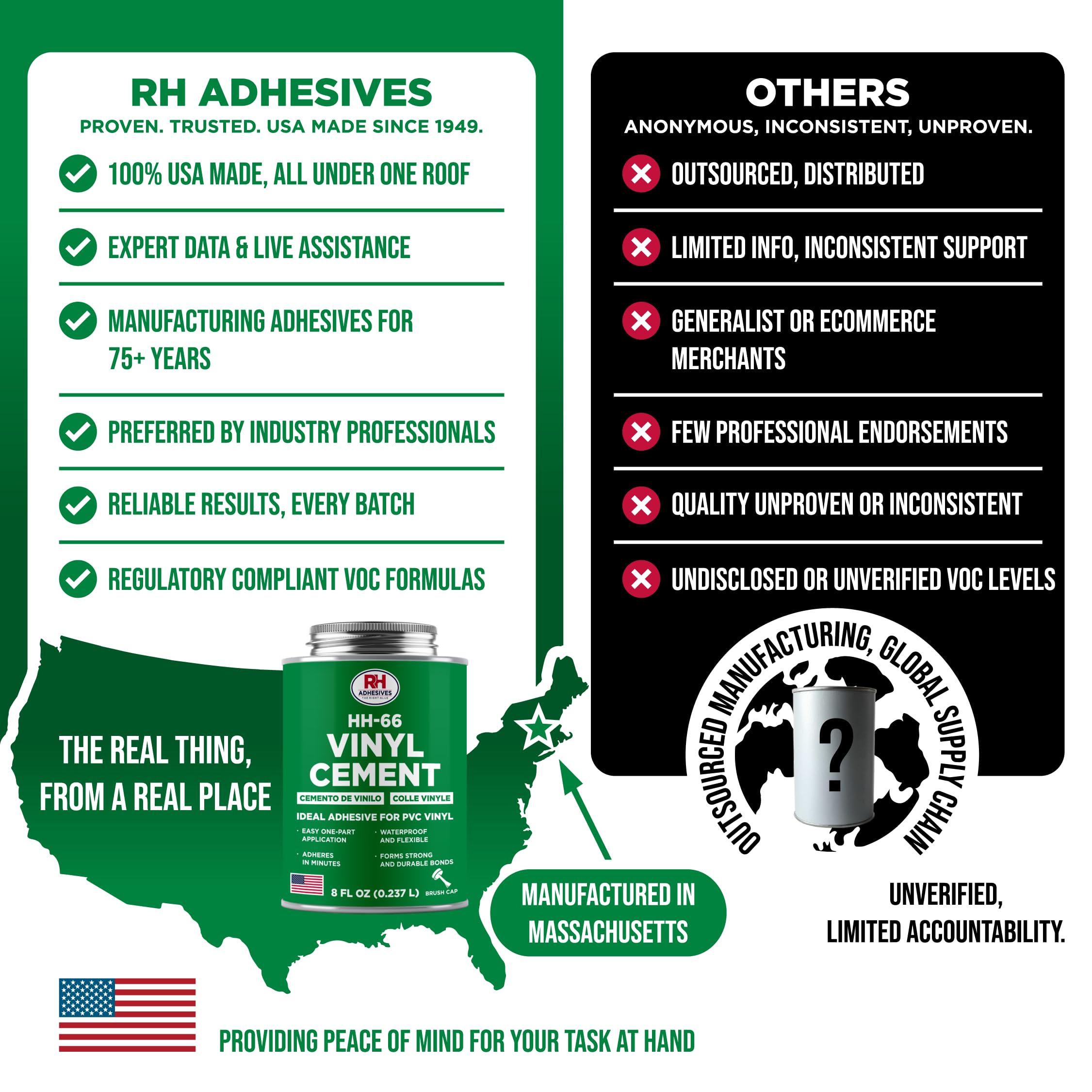






🛠️ Stick with the best—where strength meets flexibility!
RH Adhesives HH-66 Vinyl Cement is a high-strength, flexible vinyl adhesive designed for professional-grade repairs and manufacturing. It bonds effectively in temperatures from 35 to 95°F, including underwater, and works on a wide range of materials such as PVC, canvas, leather, and neoprene. Made in the USA since 1949, this 8 oz. can delivers long-lasting, waterproof adhesion ideal for inflatables, pool liners, tarps, tents, and more.

M**.
A solid performer. I'll be sticking with this over the others I've used previously! :)
I work underwater, wearing a 5/7 Wetsuit and a BARE D6 Drysuit.All that neoprene will take a hit over and over again, and I finally decided to try out a different brand than what I find in local dive/sporting goods shops..After researching various adhesives, I ordered this small can to try it out.It works really good!I tend to do as many of my own repairs on gear as I can.I also have occasion to work on other people's gear and various stuff, as well.I'm looking at getting the larger can after this one gets close to the bottom..I'm also looking at their other adhesives. It's good to understand the properties of the various adhesives, their uses, and your needs, so your repairs will be successful..This is my favorite adhesive for neoprene now.
D**S
Works great for sticking stuff to vinyl isups
Best for sticking things to vinyl isup. I've added finboxes, accessory mounts and tie down points to several isups. Never had any come loose after several years. Only problem with the can is, you need to make really sure it's tight or it dries out FAST. I've started coating the lid threads with vaseline and storing them upside down. They stay fresh that way.
J**M
Works as advertised!
This product delivered everything it was advertised to do and then some. I was able to adhere marine vinyl to Styrofoam without any issues and it's permanent! Other adhesives did not do the job like this product did.
W**G
Works great for the $
For the price this little can of adhesive not only is easy to use but works great. I applied paddle board fins in minutes. The product is very durable. I will be using it for the boards, boat and camping gear.
T**R
Really a great product to buy.
This is a great product reapolstered some pontoon boat seats. It also does a wonderful job on car seats.
A**W
Good stuff!
I have a generic paddleboard that I modified with extra D-rings and straps using the HH-66 vinyl cement. This stuff has excellent hold in heat and wet conditions. The only problem seems to be the thinner outer layer of vinyl on the attached items. The thicker center of the D-rings is solid, but the outer edges are coming loose. I do not think that’s the cement though, because the same thing happened around my fin, and I had not glued anything there… but did use HH66 to patch it. The handles are newly applied and not tested yet. The D-rings were applied last summer and have held up great with tight bungee straps holding heavy weights… even with outer edges loose in spots. My spare paddleboard also had a leak somewhere around the seal where you pump it up. I applied a couple layers around the insertion piece for pump and the leak is gone. This is my second jar of HH-66 and I highly recommend it. My only caution is do not get any of it on your clothes and don’t get any around the rim of the container or it will be permanently sealed shut 😂
A**N
Works great !
We purchased some used bounce houses that needed some work. This was recommended by our repair man . This stuff is great for quick patchworks ! Binds well , dries quick , and we don’t usually have to redo any patches after we finish
A**R
Doesn't work under water
I bought this to repair a large hole in my swimming pool liner which was just above the water liine. The product instruction tell you to paint both surfaces (i.e the liner and the patch). The patch was no problem but trying to paint the product on the liner below the water line was a disaster. As soon as it hits the water it spreads out in a thin sheet sticking to anything nearby including me (fortunalely it does not stick very well). I finally put the patch on without the liner being painted below the water. It adhered well where it was dry and less well underwater. The further down you went the less it adhered. We are planning to replace the entire liner after this season so I guess it does not matter, but I really needed an vinyl adhesive that can be applied below water. This is not it.
Trustpilot
2 months ago
2 weeks ago
2 months ago
1 week ago